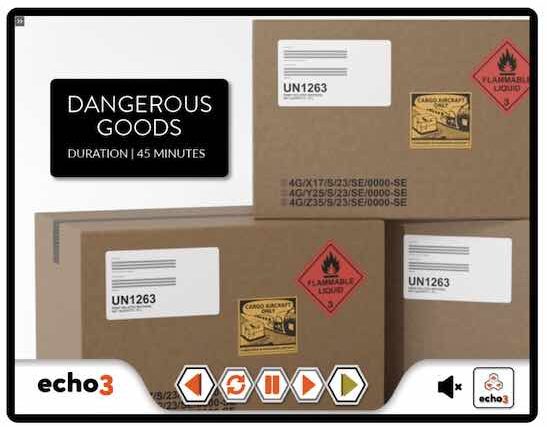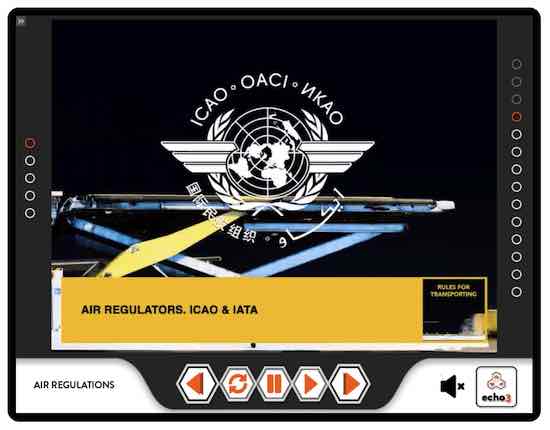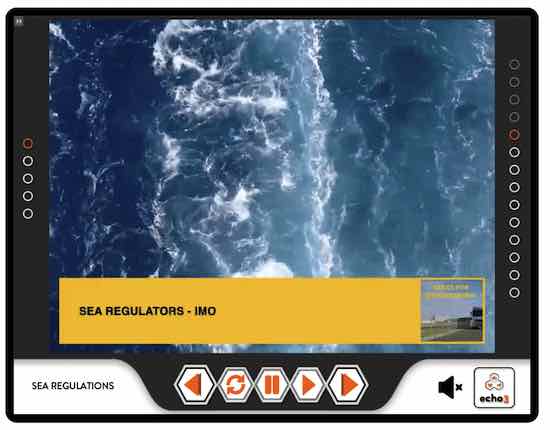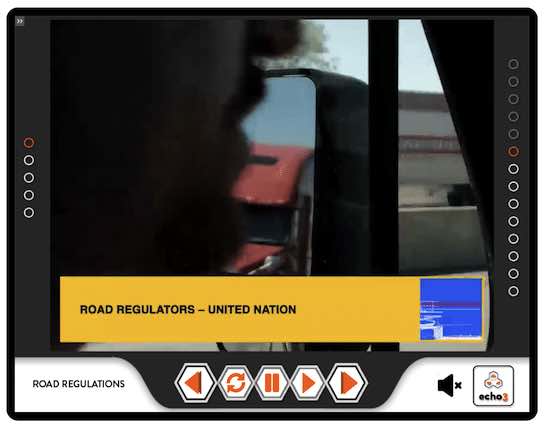Your basket is currently empty!

Transporting Dangerous Goods
Online Dangerous Goods course for everyone transporting dangerous goods or managing those that do. Provides the knowledge need to label, pack and ship goods in a safe and compliant way.
- For Me
- For Teams
DANGEROUS GOODS COURSE
This online Dangerous Goods course provides the knowledge needed to transport dangerous goods safely by Air, Sea, and Road.
‘Dangerous Goods’ is the term given to Hazardous substances when they are transported.
When transporting dangerous goods there is a risk of incidents. Especially when goods are improperly labelled, packed, or documented. A common cause of incidents is insufficient training.
By providing an overview of rules and best-practice this online Dangerous Goods course provides the knowledge needed to reduce the chance of incidents and comply with regulations.
At the end of the Transporting Dangerous Goods course is a short multiple-choice quiz. Achieve over 80% and your certificate will be emailed to you and made available for download.
Depending on your role more specific training may be required. If in doubt consult your line manager, dangerous goods safety adviser, workplace risk assessments or safety data sheets.
COURSE OBJECTIVE
This online Dangerous Goods course has been designed to help ensure staff know how to transport goods by road, air or sea safely.
When applied this knowledge will help keep your staff, couriers, handlers shippers and consignees safer.
LEARNING OUTCOMES
After completion of this online Transporting Dangerous Goods course learners will.
- Know what dangerous goods are.
- Understand where international rules for transporting dangerous goods by air, road and sea originate.
- Understand the role of IATA, IMO and ADR regulations.
- Know how to find the information or transporting any dangerous goods by Air.
- Know how to find the information or transporting any dangerous goods by road.
- Know how to find the information or transporting any dangerous goods by Sea.
- Understand how to label, pack and document dangerous goods correctly for Air, Road, or Sea transportation.
DANGEROUS GOODS CERTIFICATE
On successful completion of the Dangerous Goods course online a certificate will be emailed.
Successful completion requires the learner to demonstrate a good understanding of the manual handling course content by achieving 80% or more in the final assessment.
The assessment is a 10 question, multiple-choice quiz. The quiz can be retaken if required.
The Transporting Dangerous Goods course certificate is valid for 3 years and a posted version can be ordered separately.
DANGEROUS GOODS COURSE CONTENT
This course has 5 units followed by a quiz
UNIT 1 | Dangerous Goods and the Law
In this first UNIT you will learn what dangerous goods are and the various rules that apply and where they originate. Whether transporting goods by air, road, or sea. We cover dangerous goods classifications and packing groups and consignor responsibilities.
UNIT 2 | Transport Dangerous Good by Air
In UNIT 2 we cover how to transport goods safely by air. This means how to gather information from the IATA reference manual, correct labelling, packing and also how to complete a shipper’s declaration.
UNIT 3 | Transport Dangerous Good by Road
In UNIT 3 we outline the steps needed to transport dangerous goods by road, safely. This means knowing where to find relevant information for your dangerous good from the ADR manual. Then we cover correct labelling, packing, loading the need for vehicle plates and driver training. We also highlight the role of DGSA or Dangerous Goods Safety Adviser.
UNIT 4 | Transport Dangerous Good by Sea
In unit 4 we cover how to transport dangerous goods by sea. Specifically, we cover the finding information in the IMDG Code. Understanding maritime pollutants. How to pack and label goods safety for transportation by sea. And the correct documentation required.
UNIT 5 | Further Training Requirements
Because many incidents are caused by insufficient training. In this final 5th UNIT we cover what appropriate training is for transporting goods by air, sea or road.
WHO SHOULD TAKE THIS COURSE?
The Transporting Dangerous Goods course is appropriate for
- Business owners who are consignors. Meaning they use they use postal services, freight forwarders or couriers.
- Anyone working for a Freight Forwarders will benefit from an understand of dangerous goods rules.
- Anyone responsible or handling dangerous goods.
- Anyone responsible for packing or labelling dangerous goods ready for transport.
PLATFORM FEATURES
You can purchase for yourself or purchase and email the Dangerous Goods course to colleagues. Once they have completed the course you will be able to download their certificate.
Echo3 is a carbon negative training platform. Any training you do with us will help reduce your businesses carbon footprint.
If you have any further questions about enrolment or reporting please email us at info@lucyketcham.com.

WHAT ARE DANGEROUS GOODS?
Dangerous goods are hazardous substances in transport. Hazardous substances can pose a hazard to either, Health, Safety, Property, or the environment. The UN lists over 2,000 dangerous goods many are everyday items like batteries. With the rise of internet deliveries it is common to post goods that are dangerous without know it.
WHAT IS A DGSA?
A DGSA refers to a Dangerous Goods Safety Advisor. This person has the role of ensuring an organisation’s compliance to all of the dangerous goods regulations, and advises on procedures, training and other dangerous goods related matters.
Formal qualifications are needed to become a DGSA.
DGSA legislation applies to all member states of the European Union and the UK post Brexit. It is a qualification gained by an exam although the method of qualification varies depending on method of implementation in each member state of the EU.
Companies involved with the regular transport of dangerous goods must appoint a Dangerous Goods Safety Adviser often referred to as a DGSA.
There are exemptions to the requirement to appoint a DGSA, depending on how often your business handles dangerous goods and in what quantities.
WHAT ARE THE DANGEROUS GOODS REGULATIONS?
Dangerous goods regulations come from several sources because multiple countries and multiple transport modes are involved. Each of the Air, road and sea transport industries have their own rules (from (IATA, IMO, ADR Regulations) which are broadly internationally adopted.
Rules are written for each of the dangerous goods on the UN dangerous goods list.
WHAT IS THE UN DANGEROUS GOODS LIST?
The UN Dangerous Goods List contains more than 2,000 rows of the most transported dangerous goods. Only rare goods that require special permission are omitted.
Here is a sample extract from the UN Dangerous Goods list

DANGEROUS GOODS COURSE
This online Dangerous Goods course provides the knowledge needed to transport dangerous goods safely by Air, Sea, and Road.
‘Dangerous Goods’ is the term given to Hazardous substances when they are transported.
When transporting dangerous goods there is a risk of incidents. Especially when goods are improperly labelled, packed, or documented. A common cause of incidents is insufficient training.
By providing an overview of rules and best-practice this online Dangerous Goods course provides the knowledge needed to reduce the chance of incidents and comply with regulations.
At the end of the Transporting Dangerous Goods course is a short multiple-choice quiz. Achieve over 80% and your certificate will be emailed to you and made available for download.
Depending on your role more specific training may be required. If in doubt consult your line manager, dangerous goods safety adviser, workplace risk assessments or safety data sheets.
COURSE OBJECTIVE
This online Dangerous Goods course has been designed to help ensure staff know how to transport goods by road, air or sea safely.
When applied this knowledge will help keep your staff, couriers, handlers shippers and consignees safer.
LEARNING OUTCOMES
After completion of this online Transporting Dangerous Goods course learners will.
- Know what dangerous goods are.
- Understand where international rules for transporting dangerous goods by air, road and sea originate.
- Understand the role of IATA, IMO and ADR regulations.
- Know how to find the information or transporting any dangerous goods by Air.
- Know how to find the information or transporting any dangerous goods by road.
- Know how to find the information or transporting any dangerous goods by Sea.
- Understand how to label, pack and document dangerous goods correctly for Air, Road, or Sea transportation.
DANGEROUS GOODS CERTIFICATE
On successful completion of the Dangerous Goods course online a certificate will be emailed.
Successful completion requires the learner to demonstrate a good understanding of the manual handling course content by achieving 80% or more in the final assessment.
The assessment is a 10 question, multiple-choice quiz. The quiz can be retaken if required.
The Transporting Dangerous Goods course certificate is valid for 3 years and a posted version can be ordered separately.
DANGEROUS GOODS COURSE CONTENT
This course has 5 units followed by a quiz
UNIT 1 | Dangerous Goods and the Law
In this first UNIT you will learn what dangerous goods are and the various rules that apply and where they originate. Whether transporting goods by air, road, or sea. We cover dangerous goods classifications and packing groups and consignor responsibilities.
UNIT 2 | Transport Dangerous Good by Air
In UNIT 2 we cover how to transport goods safely by air. This means how to gather information from the IATA reference manual, correct labelling, packing and also how to complete a shipper’s declaration.
UNIT 3 | Transport Dangerous Good by Road
In UNIT 3 we outline the steps needed to transport dangerous goods by road, safely. This means knowing where to find relevant information for your dangerous good from the ADR manual. Then we cover correct labelling, packing, loading the need for vehicle plates and driver training. We also highlight the role of DGSA or Dangerous Goods Safety Adviser.
UNIT 4 | Transport Dangerous Good by Sea
In unit 4 we cover how to transport dangerous goods by sea. Specifically, we cover the finding information in the IMDG Code. Understanding maritime pollutants. How to pack and label goods safety for transportation by sea. And the correct documentation required.
UNIT 5 | Further Training Requirements
Because many incidents are caused by insufficient training. In this final 5th UNIT we cover what appropriate training is for transporting goods by air, sea or road.
WHO SHOULD TAKE THIS COURSE?
The Transporting Dangerous Goods course is appropriate for
- Business owners who are consignors. Meaning they use they use postal services, freight forwarders or couriers.
- Anyone working for a Freight Forwarders will benefit from an understand of dangerous goods rules.
- Anyone responsible or handling dangerous goods.
- Anyone responsible for packing or labelling dangerous goods ready for transport.
PLATFORM FEATURES
You can purchase for yourself or purchase and email the Dangerous Goods course to colleagues. Once they have completed the course you will be able to download their certificate.
Echo3 is a carbon negative training platform. Any training you do with us will help reduce your businesses carbon footprint.
If you have any further questions about enrolment or reporting please email us at info@lucyketcham.com.

WHAT ARE DANGEROUS GOODS?
Dangerous goods are hazardous substances in transport. Hazardous substances can pose a hazard to either, Health, Safety, Property, or the environment. The UN lists over 2,000 dangerous goods many are everyday items like batteries. With the rise of internet deliveries it is common to post goods that are dangerous without know it.
WHAT IS A DGSA?
A DGSA refers to a Dangerous Goods Safety Advisor. This person has the role of ensuring an organisation’s compliance to all of the dangerous goods regulations, and advises on procedures, training and other dangerous goods related matters.
Formal qualifications are needed to become a DGSA.
DGSA legislation applies to all member states of the European Union and the UK post Brexit. It is a qualification gained by an exam although the method of qualification varies depending on method of implementation in each member state of the EU.
Companies involved with the regular transport of dangerous goods must appoint a Dangerous Goods Safety Adviser often referred to as a DGSA.
There are exemptions to the requirement to appoint a DGSA, depending on how often your business handles dangerous goods and in what quantities.
WHAT ARE THE DANGEROUS GOODS REGULATIONS?
Dangerous goods regulations come from several sources because multiple countries and multiple transport modes are involved. Each of the Air, road and sea transport industries have their own rules (from (IATA, IMO, ADR Regulations) which are broadly internationally adopted.
Rules are written for each of the dangerous goods on the UN dangerous goods list.
WHAT IS THE UN DANGEROUS GOODS LIST?
The UN Dangerous Goods List contains more than 2,000 rows of the most transported dangerous goods. Only rare goods that require special permission are omitted.
Here is a sample extract from the UN Dangerous Goods list













